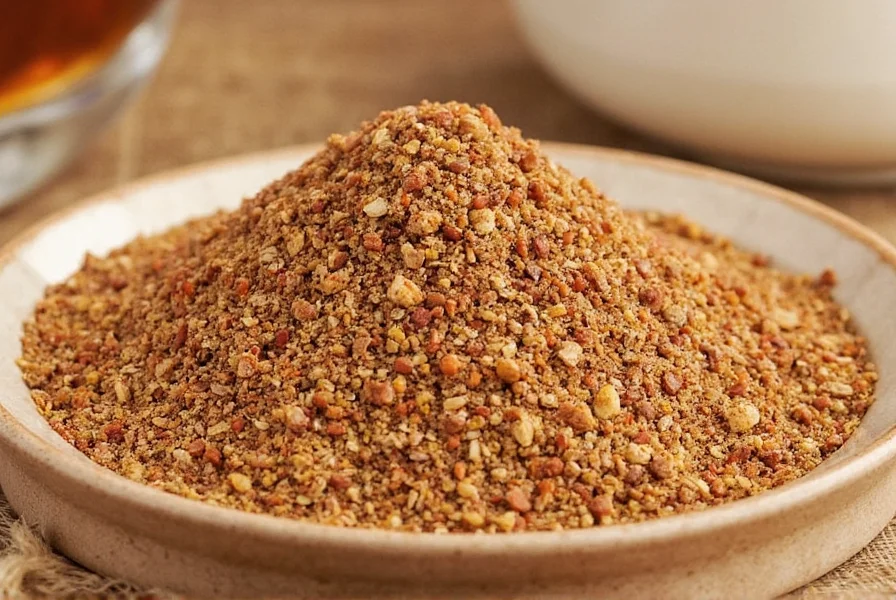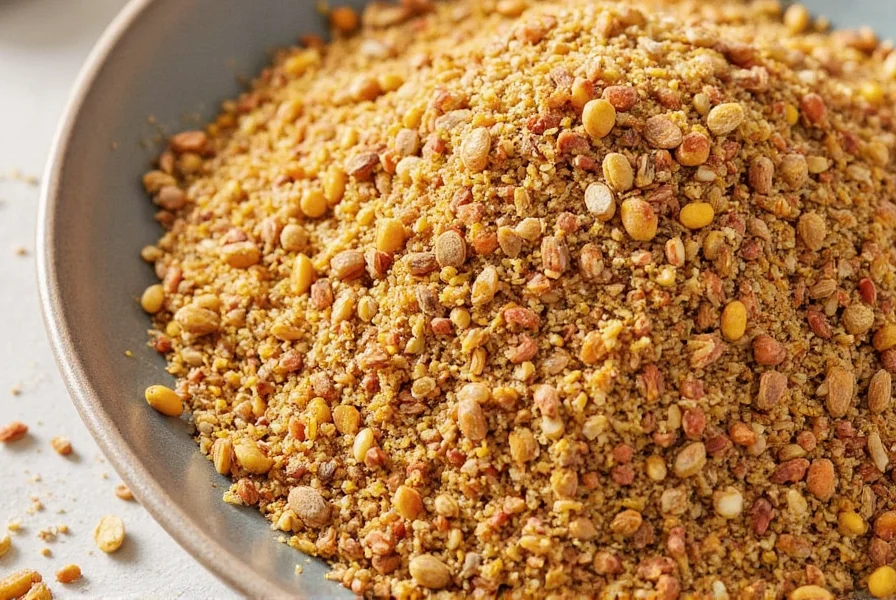Dukkah is an Egyptian spice blend made from a mixture of toasted nuts, seeds, and spices. Pronounced 'do-ka' (rhymes with 'pucker'), it has been used for thousands of years and is traditionally served as a dip with bread and olive oil. This versatile condiment adds a nutty, aromatic flavor to a wide range of dishes.
The Origins of Dukkah: From Pharaohs to Your Pantry
Dukkah has roots that trace back thousands of years to ancient Egypt. The name itself comes from the Arabic word meaning 'to crush', which gives a hint about how this spice blend is traditionally prepared — by crushing or grinding a combination of spices, herbs, and nuts.
In ancient times, dukkah was a simple mixture of ground hazelnuts, coriander seeds, and salt. Over time, as trade routes expanded and ingredients became more accessible, the recipe evolved to include sesame seeds, cumin, fennel, nigella seeds, and even dried herbs like thyme or mint.
Modern Variations Around the World
Today, dukkah recipes vary widely based on region and personal preference. While the traditional Egyptian version remains popular, chefs and home cooks alike have begun experimenting with new ingredients like pistachios, almonds, chili flakes, and even citrus zest to give it a modern twist.
What Is Dukkah Made Of? A Closer Look at Its Ingredients
To answer the question "what is dukkah", we need to look at its core components:
- Nuts: Typically hazelnuts, but also pistachios, almonds, or walnuts.
- Seeds: Sesame seeds, coriander seeds, cumin seeds, and sometimes fennel or nigella seeds.
- Spices: Crushed or powdered versions of warm spices like cinnamon, cardamom, or allspice.
- Herbs (optional): Fresh or dried thyme, oregano, or mint for brightness.
| Ingredient | Flavor Contribution | Common Substitutes |
|---|---|---|
| Hazelnuts | Rich, earthy nuttiness | Almonds or pistachios |
| Sesame Seeds | Roasty, umami depth | Sunflower seeds |
| Coriander Seeds | Citrusy, floral notes | Fennel seeds |
| Cumin Seeds | Warm, smoky undertone | Paprika (for color only) |

How to Use Dukkah in Everyday Cooking
Now that we've answered the question of what is dukkah, let's talk about how to use it in your kitchen. Spoiler: It's not just for dipping bread in olive oil anymore!
Top 5 Creative Ways to Use Dukkah
- As a Dipping Spice: Mix with extra virgin olive oil and dip crusty bread or fresh vegetables.
- Breading for Proteins: Press onto chicken, fish, or tofu before pan-frying for a crunchy, spiced crust.
- Salad Topping: Sprinkle over roasted vegetables, grain bowls, or leafy greens for texture and flavor.
- Yogurt or Hummus Boost: Stir a spoonful into yogurt sauces or hummus for an instant flavor lift.
- Seasoning for Roasted Veggies: Toss with root vegetables before roasting for a warm, aromatic finish.
Dukkah vs. Za'atar: Understanding the Difference
You might be thinking, "Isn't dukkah the same as za'atar?" Great question! Both are Middle Eastern spice blends, but they differ in composition and usage.
| Feature | Dukkah | Za'atar |
|---|---|---|
| Main Ingredients | Nuts, seeds, spices | Thyme, sumac, sesame seeds |
| Texture | Crunchy, coarse | Smooth, fine |
| Flavor Profile | Earthy, savory, nutty | Tangy, herbal, bright |
| Common Use | Dipping, breading | Rubbing, seasoning flatbreads |
Making Your Own Dukkah at Home
Want to skip store-bought versions and make your own? Good news — it's easier than you think!
Homemade Dukkah Recipe (Makes About ½ Cup)
- ¼ cup hazelnuts or almonds
- 1 tbsp coriander seeds
- 1 tsp cumin seeds
- 1 tbsp sesame seeds
- ½ tsp black peppercorns
- 1 tsp dried thyme or mint (optional)
- Toast each ingredient separately in a dry skillet until fragrant.
- Let cool slightly, then pulse in a food processor or mortar and pestle until coarsely ground.
- Store in an airtight container for up to 3 months.
Buying Guide: How to Choose the Best Dukkah
If you don't want to make your own, there are plenty of high-quality dukkah products available. Here's what to look for when shopping:
Things to Consider When Buying Dukkah
- Freshness: Check the expiration date and opt for brands that use small batches or vacuum-sealed packaging.
- Ingredients: Avoid blends with unnecessary additives or preservatives. Look for whole spices and real nuts.
- Texture: A good dukkah should be coarse and slightly chunky, not overly powdery.
- Brand Reputation: Choose brands known for quality spices and authentic Middle Eastern flavors.
| Product Name | Key Features | Best For | Occasions |
|---|---|---|---|
| Epicurean Trader Dukkah Blend | Hand-blended, organic, no additives | Home cooks who love authenticity | Gifts, dinner parties, everyday meals |
| Souk Dukkan Traditional Egyptian Dukkah | Imported from Egypt, traditional hazelnut base | Travelers missing Egyptian street food | Charcuterie boards, bread dips |
| Harvest Moon Nutty Dukkah | High nut content, sweet-spicy balance | Those who prefer a richer flavor | Baked goods, desserts, yogurt parfaits |

Frequently Asked Questions About Dukkah
Here are answers to some common questions about this versatile Egyptian spice blend:
What is dukkah exactly?
Dukkah is an Egyptian spice blend made from a mixture of nuts, seeds, and spices that are dry-toasted and coarsely ground. It's traditionally used as a dip with bread and olive oil but has many modern culinary applications.
How do you pronounce dukkah?
Dukkah is pronounced "do-ka" (rhymes with "pucker"). The name comes from the Arabic word meaning "to crush," which refers to how the ingredients are prepared.
What does dukkah taste like?
Dukkah has a complex flavor profile that's nutty, earthy, and aromatic with warm spice notes. Depending on the specific recipe, it can have citrusy (from coriander), smoky (from cumin), and sometimes slightly sweet or herbal notes.
How is dukkah traditionally used in Egyptian cuisine?
In Egypt, dukkah is most commonly served as a dip. Egyptians place a small mound of dukkah on a plate, pour good quality olive oil around it, and then dip fresh bread into the oil and then into the spice blend.
How long does homemade dukkah last?
When stored in an airtight container away from heat and light, homemade dukkah will stay fresh for about 2-3 months. The nuts provide natural oils that help preserve it, but for best flavor, use within one month.
Is dukkah gluten-free?
Yes, traditional dukkah is naturally gluten-free as it contains only nuts, seeds, and spices. However, if you have celiac disease or severe gluten sensitivity, check store-bought versions for potential cross-contamination.
Can I make dukkah without nuts for allergies?
Absolutely! While nuts are traditional, you can make a nut-free version using extra seeds (like sesame, pumpkin, or sunflower seeds) to maintain the crunchy texture. This works well for those with nut allergies while still delivering great flavor.
What's the difference between dukkah and za'atar?
While both are Middle Eastern spice blends, dukkah is characterized by its nut content and coarse, crunchy texture, while za'atar is primarily herbs (thyme, oregano, marjoram) with sumac and sesame seeds, resulting in a finer, more powdery texture. Dukkah is more earthy and nutty, while za'atar is tangy and herbal.
Conclusion: Dukkah Is More Than Just a Trend
So, to wrap it up — what is dukkah? It's more than just a fancy spice mix; it's a bridge between tradition and innovation, flavor and texture, simplicity and sophistication. Whether you're sprinkling it over eggs, using it as a crust for salmon, or simply dipping warm bread into olive oil and dukkah, this versatile blend brings a touch of the Mediterranean to your table.
Once you understand what dukkah is, you'll find endless ways to incorporate it into your cooking. So go ahead — open that jar, toast some nuts, and enjoy every bite of this magical spice blend!










 浙公网安备
33010002000092号
浙公网安备
33010002000092号 浙B2-20120091-4
浙B2-20120091-4